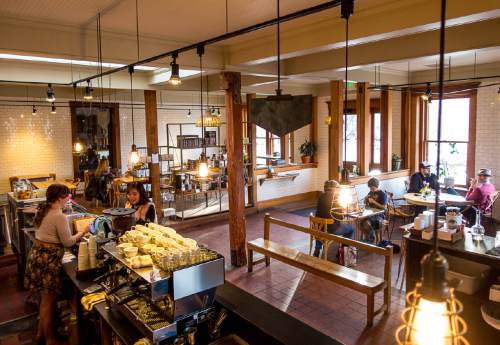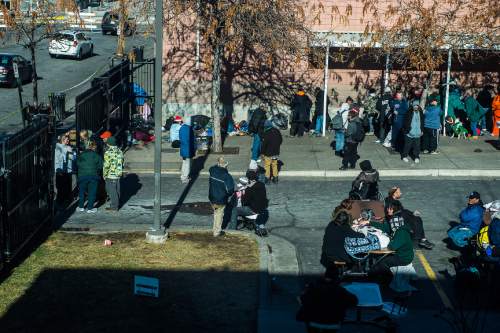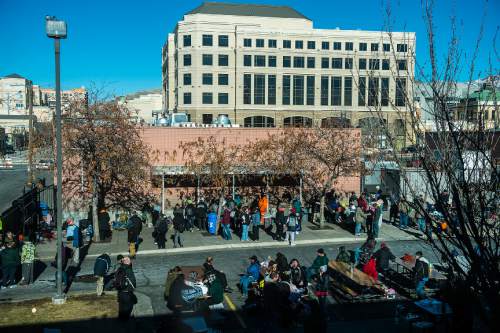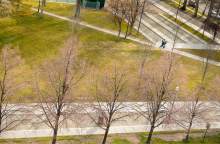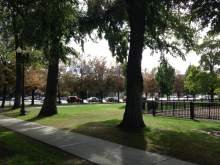This is an archived article that was published on sltrib.com in 2015, and information in the article may be outdated. It is provided only for personal research purposes and may not be reprinted.
As news travels across the country that Utah has all but eliminated "chronic" homelessness, the scrum continues in Salt Lake City over what to do with the other 14,000 people who don't have a place to call home.
A push to gentrify the Pioneer Park area is one of the factors sparking renewed debate about homeless services, as is an uptick in drug trafficking and accompanying crime in the Rio Grande District.
With pressure building, Mayor Ralph Becker created the Homeless Services Site Evaluation Commission last December to determine if those services were being delivered efficiently and whether The Road Home shelter should be upgraded or moved.
Critics have said the commission's name, alone, points to a predisposition to move The Road Home shelter to make way for upscale condos, shops and restaurants.
Although the Salt Lake City Council was not included in the new homeless commission, it may play a key role if recommendations due in November point toward moving the shelter and allied service providers. Such a relocation would require a council-endorsed zone change — and that is anything but a given. The council earlier recoiled from suggestions that The Road Home be pushed westward.
Chronic homelessness is defined as being homeless for more than one year or being without a home four times across three years and having a diagnosed disability or substance-abuse problem. Last month the state Department of Workforce Services said its program had found homes for 90 percent of the state's chronically homeless that numbered more than 2,000 a decade ago.
But most homeless folks find a new nest within a 12-month period, thanks, in part, to service providers who get them back on their feet. Nonetheless, during the past 10 years, that number has vacillated around 14,000 — and many of those people rotate through the Pioneer Park area.
Some fear that real estate and businesses interests heading up the Pioneer Park Coalition could propel a shelter relocation. And late last month, one service provider wrote to the mayor to say the way his new commission is defined may have set the stage for an outcome that would exclude the homeless from the greater community.
Glenn Bailey, executive director of the Crossroads Urban Center, wrote: "We are concerned that there is a lot of energy around relocating and/or reorganizing homeless services but no long-term commitment to how those services will be funded and maintained once they are established."
In an interview last week, Bailey said he feared the commission may be steered toward a "campus approach" that would provide a shelter and all homeless services in one location aimed at keeping this population away from the general public.
"To put them behind a wall is not acceptable," Bailey said. "They are part of the community."
Further, Bailey said in the letter that the commission has not articulated a statement of need. How that is defined is critical, he said.
"For example, is the problem too many people hanging out on Rio Grande Street or is it a lack of affordable housing?" he asked. "Is it crime in the [Rio Grande] Depot District or a lack of day services for homeless people?"
Bailey also noted that the Pioneer Park Coalition has invited Robert Marbut to address its May 14 meeting in EnergySolutions Arena at 11:45 a.m. Commission members may also attend. Marbut is a recognized national figure who supports the homeless-campus approach.
Asked about Bailey's letter, Becker said he did not agree that his homeless commission — by definition or makeup — is tilted toward any outcome. He noted the 30-member group is made up of private-sector homeless-service providers and government social service representatives, as well as business interests.
"I disagree completely [with Bailey]," he said. "The proof will be in the pudding."
Former Salt Lake City Mayor Palmer DePaulis serves as commission co-chairman along with businesswoman Gail Miller. DePaulis said at this point the group is looking toward solving issues.
"We made a strong effort to get people to focus on interests [like safety and access to transportation], and how we can best do this for the homeless community," he said. "We have not allowed a discussion on a final solution yet."
Whether to move the shelter is only part of the new commission's charge. Salt Lake County Mayor Ben McAdams is heading up an effort that is analyzing the effectiveness of how money is spent on homeless services.
"The county has lots of data for what works and what doesn't work," said spokeswoman Alyson Heyrend. "We'll focus on what's working and not be parochial about what isn't working. You have to go where the data lead."
That analysis could be key in steering the commission's recommendations, Heyrend said, because it is not subjective.
The commission's next public meeting is scheduled for May 15 at 1:30 p.m. in the downtown Salt Lake City Library's fourth floor conference room.



